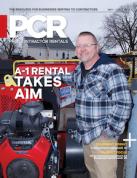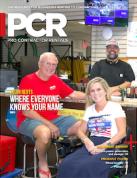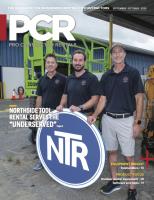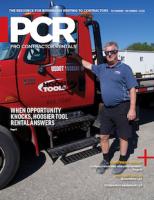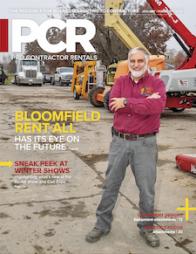Industry Outlook: Power up with portable generators
New models meet tougher EPA standards and higher rental customer expectations.
Portable generators play an important role in rental fleets. Like telehandlers, they are often one of the first pieces of equipment on a site and one of the last to leave.
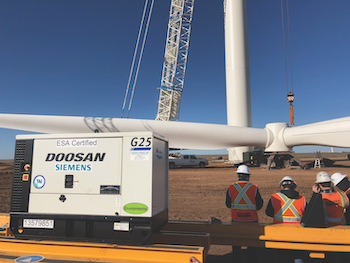 |
Customers see them as a critical link in their operation and reliability is paramount.
With the increasing complexity of new models, it’s more important than ever to right-size units. Tire 4-compliant models must be well-matched to the load to prevent wet-stacking problems.
Pro Contractor Rentals asked leading portable generator experts how rental centers can best position and deliver portable generators to their customers. Find out what they recommend.
 |
| Angel Nieto, Product manager -- Power & Light, Atlas Copco Power Technique |
Paralleling opens opportunities
Paralleling of generators is gaining traction in the generator market. The increasing demand of this solution is due to the huge versatility and redundancy that it is bringing to the rental fleets as well as a more friendly interface, which does not require high technical competence. The necessity of larger power node generators has been moderated by paralleling smaller ones.
We are also seeing an increasing awareness of green solutions. Energy storage systems are taking advantage of the improved performance that new battery technologies are bringing.
Rental companies can take advantage of these emerging trends by having their equipment ready for rent at all times. This can only be achieved by reducing downtime and have the right size and models in the yard. Some ways to achieve this, among others, are regular scheduled preventive maintenance, telematics to monitor the condition of the equipment, good technical and parts support and the ability to use paralleling controllers to increase the versatility of the fleet.
Availability of the equipment is critical because customers often cannot predict their power needs. A correct physical deployment of the equipment in areas where a peak demand is expected because of atmospheric events will help increase the usage ratio of the equipment.
Additionally, rental centers that offer portable power generation need quality and fast technical support. They need access to accurate and efficient advice in equipment selection and also in the event of a technical issue during operation.
 |
|
Gareth Osborne, product definition manager, |
Need for increasing complexity and user simplicity
Power density is a major trend. In terms of engine capacity and package footprint, it allows the generator set to be deployed across a multitude of applications, from construction to events, where size may be critical.
Connected assets are another trend. They facilitate real-time monitoring and diagnostics as well as trend analysis over time. This allows the user to predict when extra attention will be needed, which could be the result of a fault with the machine or a unit that has continually low utilization that could be replaced with a smaller, more cost-effective generator set.
Finally, the trend toward emissions reduction has led to environmentally friendly Tier 4 Final certified products with selective catalytic reduction (SCR) and diesel emissions fluid (DEF) to reduce nitrogen oxides (NOx). Tier 4 Final emission standards set by the U.S. Environmental Protection Agency (EPA) have reduced NOx by a further 80 percent from Tier 4 Interim standards. Most manufacturers use a combination of engine and after-treatment strategies to ensure compliance for new equipment.
Longer engine service intervals can improve owning and operating costs for customers. When the need for periodic maintenance can be reduced and generator sets run for longer periods between service calls, customers save on downtime. The cost of consumables such as oil and filters is also reduced, along with labor and travel costs.
Integrating telematics information into business systems and improving operational efficiency, systems such as Cat Connect technology is available to remotely track and manage generator sets. It collects data and reports on asset performance, run hours, fuel consumption, maintenance needs and other statistics. This timely information allows customers to better control costs, improve performance and reduce risks. Cat Connect technology can be used on generator sets and machines built by Caterpillar as well as equipment that is connected to the generator set, such as external fuel tanks for extended running, transformers or temperature control equipment.
Rental customers have a need for simple and intuitive generator set control systems. Controls are one of the most commonly accessed areas of the generator set, and need be clear and concise for operation and fault finding. Caterpillar developed the Cat EMCP 4.2B generator set controller specifically to address the needs of rental operators. A user-friendly interface allows for engine and generator set monitoring and control, along with features for advanced users including a built-in programmable logic control (PLC).
Access to remote monitoring information ensures that generator sets are being utilized correctly and are ready to run when needed. Telematics can send real-time information on fuel level, battery voltage and status (Run/Stop/Auto). This information can be actioned quickly, before the generator set is called to start, ensuring no issues occur when power is needed.
With the introduction of exhaust after-treatment to ensure EPA Tier 4 Final standards are met, thermal management of the generator set has also become very important to ensure the SCR converts enough NOx to water and nitrogen. Equally important is the ability to regenerate, removing soot from the particulate filter to ensure continued operation of the generator set. Caterpillar gernerator sets achieve this process transparently to the operator, without the need to take the generator set offline or add load banks and other equipment that increases complexity, cost and weight.
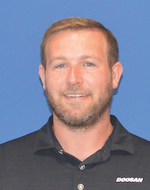 |
| Travis George, product manager, generator & light towers, Doosan Portable Power |
Leverage telematics data
Telematics and overall generator performance are two emerging trends in the power generation field.
The ability to have any type of machine data at your fingertips is a major advantage in the power generation market. There are many benefits to the connected-machine solution. Being able to monitor a machine on a job site and react to fault codes or alerts before it affects the end user’s productivity allows rental centers to send a technician to the machine location and repair the issue before the end user experiences any downtime. There are also benefits in terms of monitoring machine hours for preventive maintenance and even billing. The generator market hasn’t fully captured the full potential of telematics just yet.
The other area is generator performance in varying applications and environments. New technology is addressing issues such as cold weather and low-load applications. Doosan Portable Power has developed a solution for load management that allows end users to avoid downtime caused by wet-stacking and exhaust fouling that can occur in low load and colder climates. The technology automatically adjusts the engine and exhaust temperature with supplemental heat to ensure the generator operates at full capacity regardless of load demand. The intelligent load management system (ILMS) requires no operator control or monitoring and eliminates the need for a load bank.
It’s an ideal option for rental applications where load demands are either unknown or incorrectly sized. For applications with fluctuating power demands, the system can instantly respond to ensure full generator capacity is available in the event of a sudden heavy load demand, such as a motor start.
Rental centers can leverage their knowledge base on this new fleet of generators and advanced technology to match customers’ needs with the right generator models and options.
Tier 4 Final machines, in general, are extremely complex. Rental stores can take on the burden of learning all there is know about Tier 4 machines for their customers by providing them with the information that is relevant to their job site demands and business needs.
The first issue is dealing with the complexity of the Tier 4 generators. Rental centers can address this issue by training sales staff to educate rental customers on the proper operation and care of generators. It’s important for the rental customer to understand the DEF requirements and how to react to alerts or fault codes on the job site.
Another issue is making sure the generator is properly sized for the application, not just what the rental customer requests. It is crucial to ask how the generator will be used. An undersized generator is not going to perform adequately and an oversized generator will develop issues tied to underloading. Properly sized generators result in happy rental customers and rental generators with fewer service and maintenance issues, leading to a longer machine life.
Understanding how and where a generator is going to be used also allows for customization or solutions for harsh applications, such as ILMS for colder climates or telematics for remote locations. Rental centers should serve the needs of customers by being knowledgeable on generator options and customizations.
 |
| Tim Doling, global director of business development, Powr2 |
Climate change, emissions driving power generation change
A huge increase in awareness of potential climate change has resulted in a global drive to reduce reliance on fossil fuels and carbon emissions.
On the diesel engine side, the EPA has enacted regulations to limit particulate emissions – therefore the introduction of Tier 4 engines on generators and other machinery. Tier 4 regulations may reduce particulate matter or black soot and nitrogen oxides (NOx) but does nothing to reduce C02. Many Tier 4 generators have a built-in load bank or heating device that adds a parasitic load to prevent operational issues, but causes units to burn more fuel and create more emissions.
The realization that Tier 4 is not the final answer to pollution issues has led companies to look for cleaner alternatives. This has naturally resulted in an increase in energy storage and hybrid energy solutions.
Hybrid power systems such as Powr2’s Powrbank can be installed between a diesel generator and the load. The Powrbank, essentially a large battery system, will automatically sense the load and turn the generator off during periods of low load and switch it back on to handle peak loads or to recharge the battery.
The introduction of energy storage has also allowed for the harvesting of renewable sources such as solar. The resulting benefits for end users are lower fuel usage, emissions, less service intervals and no downtime/loss in power for servicing and reduced running costs.
The rental company also benefits from having reduced hours on the generator, no wet stacking on the generator, fewer service calls and complete visibility of what the load is via the remote management software.
The rental sector will always have its doubters, but the key thing to adoption of these types of products is awareness and training. Tell your customers about the technology and applications where it may make sense. Reduce the perceived risk of adoption by offering a trial period to see if the product meets expectations and then provide data to show what it has achieved.
The most common mistake is a perception that the client won’t pay for it, even when they don’t even know it exists. Add it to the generator quote – that will at least start the conversation about the new technology.
Hybrid power products are a conundrum for many rental companies. While having obvious environmental and operational benefits, they also create the risk of negatively impacting other revenue streams.
Hybrid manufacturers boldly but accurately claim reductions in fuel and emissions of up to 80 percent. The number of hours on the generator and frequency of service visits in the field are reduced in accordance with the lower run time. On top of these benefits, wet stacking of generators or having to add parasitic loads to prevent wet stacking is no longer a worry.
For most rental centers, there are three or four revenue streams: basic rental rate; additional shift rental for running longer than eight hours; additional service charges for maintenance; and revenue from fuel sales. When adding a hybrid power unit, you may reduce or eliminate three of these four revenue streams.
For example, if a generator rents for $1,500 a month and the client plans to run it 24/7 so the rate doubles to $3,000. Because it is running it 24/7, it needs to be serviced twice a month at a cost of $250 per call. If the rental center sells the fuel at $4 a gallon at a burn rate of 1 gallon an hour on average, this adds up to $2,688 in fuel sales. Based on that, the total income from this rental will be $6,188 per month.
Customers who use a hybrid Powrbank will find the generator operates only four hours a day instead of 24, so they are eligible for the single-shift rate. Lower operating hours per month mean the unit needs service once every two months and the fuel burn will be lower at 2.5 gallons for 4 hours on each 24-hour period. The new revenue looks like this: $1,500 (rental rate) + $125 (servicing) + $1,120 (fuel) for a total of $2,745. That reduces the revenue by $3,443 per month on that unit. How can that revenue be justified to shareholders?
Consider these points:
• Don’t underestimate the climate change movement. The ability to harvest renewable energy appeals to event organizers and large contractors. They are looking for ways to further reduce their carbon footprint. Charging a rental rate for the hybrid equivalent or greater than what you are losing in other revenue is possible as the client understands the additional environmental benefits.
• Revenue from fuel is typically low margin and can even negatively affect rental company financials. Some rental centers avoid selling fuel altogether, so the hybrid power source can be rented like any other asset.
The hybrid power unit has a lower total cost of ownership as it is largely maintenance free. With battery cells rated for 10,000 discharges, the asset life is more than 10 years.
• Revenue from servicing is not always profitable and can be difficult to maintain the correct service intervals if the generator is in a remote location. Plus, skilled service labor is getting harder to find, so any reduction in servicing is an operational benefit.
• It’s highly likely the generator’s resale value and life will increase because it will run for far fewer hours.
• Wet stacking issues and servicing downtime on site are eliminated.
• The battery also serves as an uninterrupted power supply for critical applications.
• The power source is almost silent, ideal for events and night work.
By offering hybrid power products, clients will perceive that your rental company aligns with their visions for sustainable planet and that you care.
To make hybrid units successful in a rental operation, try these approaches:
1. Focus first on applications where the customer is willing to pay more for these features. This could be the need for silent power in areas where there are noise ordinances or where emissions are sensitive, so a green solution is appreciated. Identify applications where the generator is running for long periods of time and see if hybrid power could reduce that run time.
2. Pass along servicing savings and some of the fuel savings. Fuel sales are usually low margin for a rental company. This still leaves an attractive return for the hybrid.
3. Be ready for coming larger sizes.
4. Reinforce system sustainability.
5 Add hybrids to quotes as a way to start the conversation.
This article appeared in the January-February 2020 issue of Pro Contractor Rentals magazine. © 2020 Urbain Communications LLC. All rights reserved.



